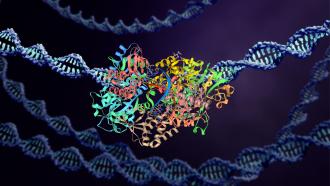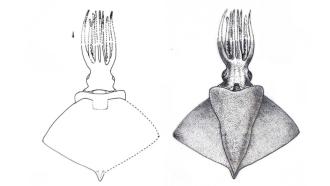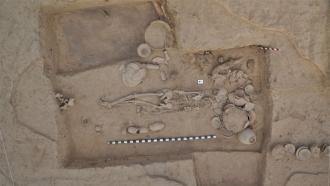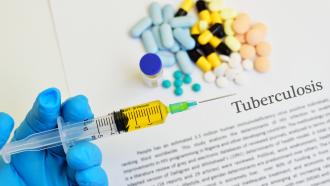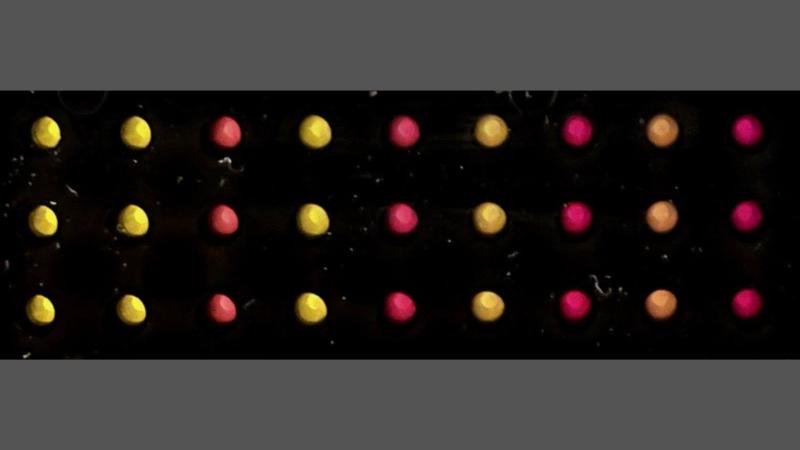
Image: A representation of the paper-discs with the substrate and cell free extracts together with (left to right) increasing concentrations of the sensor without trigger (yellow) compared to with trigger addition (shades of red). Credit Prof Chaitanya Athale
It was 18 March 2020. An immediate and drastic lockdown had been imposed in India to deal with the rapid spread of SARS-CoV-2. This was a novel coronavirus that was rapidly spreading, leaving death in its wake, leading to it being declared a global pandemic. An .. Very few people knew what was going to happen next or that it would be two years before we would return to something like normalcy. All this was the result of a tiny organism that we can't see even after 1,000 times magnification!
Reports from medical policymakers suggested COVID-19 tests, particularly qPCR kits, were limited (Gangakhedkar, 2020). The suggested strategy of “storing kits before it gets worse” was, however, based on a lack of capacity, the presence of 13 Virus Research and Diagnostic Laboratories (VRDLs) spread across India (Gupta et al., 2020) notwithstanding. Thus, building surge capacity for diagnostics was of utmost importance. Synthetic biology has always offered a way to achieve this at scaled diagnostics.
Riboswitches, referred to as toehold RNA, have been widely tested in the iGEM student synthetic biology contest with reasonable success. Modifications to mRNA (messenger RNA is the way a cell converts DNA information into protein) can, with clever engineering, be harnessed to act as RNA biosensors for a wide range of targets, ranging from drugs to heavy metals and tuberculosis.
Back in March 2020, I began to wonder -- could this very obvious and robust technique also be used to detect viruses?
As it often happens in scientific research, if you think you have a good idea, go read if somebody has already done it! A reminder to “read the literature” before embarking on risky projects.
So indeed, the Boston-based group of James Collins at Boston University and then MIT, together with Keith Pardee and Alex Green, pioneered such RNA-based viral detection sensors in 2016. They employed the sensors for detecting the Zika virus using a multi-step approach: amplification of the viral RNA, demonstrating its use in Brazil in conditions without sophisticated labs (Pardee et al., 2016). They used purified cell extracts to make the reaction work on paper discs.
In April 2020, there was no evidence for this approach working for SARS-CoV-2.
So, I finally set myself at my computer to see if I could figure out how to design these circuits. After many discussions with colleagues inside my institute, I realised a USA-Canada-based group knew the intricacies. So, I did what is fantastic about science - reached out and received positive responses. This is one of the joys of doing scientific research, since it is universal and a shared enterprise. Keith Pardee, an associate professor in Pharmacology at University of Toronto, wrote back, thus starting our journey.
With small funding support from the institute and despite the lockdown, we began work on developing a sensor for the COVID-19 virus. Genome sequences were rapidly becoming available, first from China and then from the rest of the world. Despite all kinds of hurdles, from restrictions surrounding in-lab work to a lack of funding and experience, we moved ahead. Luckily for me, a talented new biotechnology postgraduate, Tanvi Kale, had agreed to join my lab. Together, we started meeting our Canadian collaborators, designing sequences, and requesting DNA synthesis companies to make the desired sequences. Then, to our good fortune, an opportunity arose, sponsored by the Ministry of Human Resource Development, Government of India, and the Canadian Government, to fund research aimed at mitigating the COVID-19 pandemic as a rapid response. We applied and were very delighted to receive approval from the Shastri Indo-Canadian Institute (SICI). We could also hire a project assistant, Rudvi Pednekar, who also came on board. Together, we began our journey.
In the paper that is now published, we asked: Can we reduce the number of steps involved in toehold RNA detection by eliminating one of the steps in the reaction without loss of sensitivity?
It was clear to us that there would be a tradeoff between sensitivity to specificity, to detectability. To this end, we borrowed a viral sequence called the translational enhancer from the virus T7, which infects bacteria (called a bacteriophage). This enhances protein production when tagged to an existing protein. Combined with an enzyme used by molecular biologists, beta-galatosidase, for a colour reaction when combined with the substrate, we had our circuit ready.
The key was to now add COVID DNA into this, all of which was made inside bacteria. Using just 37 base pairs of the COVID genome, part of the N-gene, we replaced the existing Zika Virus sensor. Testing the circuit using purified RNA, we found we could detect as low as one pico-molar, comparable to typical patient sample RNA content – that translates to 10^9 copies per millilitre. While PCR can detect even 1 copy per ml, this method provides a field-usable device that eliminates the need for sensitive equipment, trained personnel and expensive reagents.
While it is not a complete solution, in the absence of anything else, it can indicate whether there is any cause for concern. One additional step was required to reduce costs further, and then we sent the sensors by courier to our collaborators in Chile. These were part of a larger Canadian Government-funded consortium along with South America, led by Dr. Pardee in Toronto. There, in the lab of Dr. Fernan Federici, his students, Severine Cazaux and Valentina Letelier, combined to test the same biosensors using cell lysate – effectively, cells crushed and used to perform the same reactions.
While the results were not as sensitive as those we observed using commercial reagents, they were comparable. Most importantly, they addressed the reproducibility of the work, that too in another continent, another lab, the same experiments gave the same results!
We are now working on improvements to the test, expanding this to other viruses and hoping to even test it on human patient samples.
The study described here has been published in the journal ACS Synthetic Biology of the American Chemical Society and can be found here: https://pubs.acs.org/doi/10.1021/acssynbio.4c00861
This article was written for Research Matters by Dr. Chaitanya A. Athale, Div. Of Biology, IISER Pune.
Email: cathale@iiserpune.ac.in

